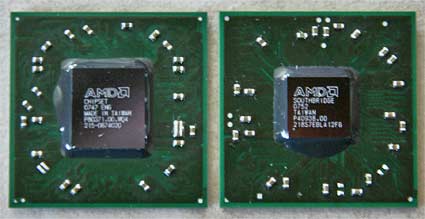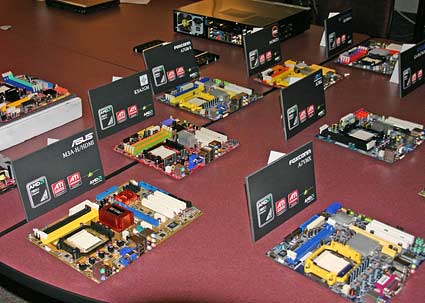Update: AMD's Chipset Game: Rien Ne Vas Plus
Markham (ON) - AMD's has raised its bet and placed its chips in a cutthroat chipset market: To gain ground on Nvidia and Intel, the manufacturer decided to put a fully-fledged GPU into its next mainstream integrated chipset 780G, which could win the company lots of new customers. But it could cost AMD lots of discrete graphics card sales as well and cut deep into its profit margins. Will AMD win and what does the 780 mean to you?
On a Roulette table, you typically meet two types of players. Those who simply try to stay in the game as long as possible while holding on to their budget for as long as possible. Simply participating will get you a nearly 50/50 or a nearly 2/3 chance when playing the outer fields. You'll never win big, but you won't lose big either. However, if you want to catch up to the big boys, you'll have to take higher risks that could leave you bankrupt or propel you to the top of the table.
AMD's chipset division is in such a game right now. Let's watch.
AMD has lost touch with the other big players, Intel and Nvidia, and is behind. There's nothing to get particularly excited about AMD's chipsets these days and the company could continue its current game and probably would be ok, if it pushes its platform message strongly. But the next bets in this game, the 780G and 780V, are now on the table and we know AMD's strategy: The green team wants to join the high-rollers again and takes an unexpected risk that could surprise the others or fail miserably.
The big picture: Upvalue the chipset, devalue cheap graphics cards
Integrated graphics chipsets are the commodity in the graphics chip industry. They are in the very low-end of PCs, but account for the lion's share of the market in terms of unit numbers. You don't talk about them, they simply do their job. And for some time now, they are even good enough again to run today's standard Windows operating system. No one who buys a PC with a graphics chipset really cares (or cannot afford to care) about the graphics performance. But this may be different with this new 780G chipset, which is aiming for cheap and mainstream PCs in the $399 and $499 price range.
Technically, from a performance view, the 780G isn't just a chipset. It really is a $19 chipset that performs (we believe AMD on this one for a moment) like a $50 entry-level standalone graphics card. In the past, a graphics chipset was based on a recent graphics engine, but usually saw substantial downgrades to keep a clear performance and price distance to the discrete product. AMD claims that in the 780G there is a full R620 graphics chip, just like in its current entry-level graphics cards, offering a performance similar to that of, well, $50 graphics cards.
Get Tom's Hardware's best news and in-depth reviews, straight to your inbox.
That means, of course that the 780G offers the R620 DirectX 10 core, which includes two independent display controllers (VGA and HDMI/DVI/DP with HDCP), a Hypertransport 3 interface and two PCIe Gen 2 interfaces. There's also a new Displaycache, which cuts down power consumption. In terms of core data, there are two versions of the 780: The base 780V (codenamed RS780C) is clocked at 350 MHz and integrates a Radeon 3100 engine; the more interesting one is the 780G (codenamed RS780), which runs at 500 MHz, runs a Radeon 3200 engine, supports UVD as well as Hybrid Graphics, which allows users to combine the integrated chipset with a discrete graphics card to increase the system's graphics performance. We will return to that further down.
The decision to put such a capable chip into the 780G has really two effects: From an application view, AMD increases the value of the chipset again, in a similar way Windows Vista devalued it: When Vista launched, your average chipsets, especially Intel's 915 and 945 were pretty much useless, since they couldn't run the software's fancy eye candy. So you had to go with a 256 MB discrete graphics card and it is still a good idea to do so today. However, the 780G brings up the performance to a pre-Vista time and lends chipsets new credibility.
However, on the other side, if that chipset is good enough for Vista, why would you or an OEM keep using a $50 graphics card, if a $19 chipset does the job just as well? AMD's corporate vice president and general manager of the firm's chipset division, Phil Eisler, conceded to TG Daily that there is a certain danger that the company could shoot itself in the foot with this chip: This chip could cannibalize discrete sales. "We have had an internal debate about that," he said. We have no doubt about that, especially since this chipset is claimed to playback HD DVD and Blu-ray without problems (something you only could do with a high-end graphics card 18 months ago) and to run almost any mainstream PC game out there. AMD itself calls the 780G "the by far fastest motherboard GPU we have ever built." So, if the 780G is really that good, it is a clear money saving opportunity for OEMs, which potentially could drop discrete graphics cards from their systems - not just Nvidia cards, but ATI Radeon cards as well.
From that perspective, the decision to use a full R620 core for the 780G is a risky play, but it will also challenge Intel and Nvidia. Intel, of course, is the main target and AMD claims that the 780G is more than twice as fast as Intel's G35 under 3DMark06, almost three times as fast under 3DMark05and achieves frame rates of 27 fps under Crysis (1024x768), 43 fps under Call of Duty 4, 40 fps under Half-Life 2 and 35 fps under Doom 3. (UPDATE: First reviews of the 780G are in: PC Perspective, TechReport)
Hybrid Graphics
To compensate for the risk of selling fewer discrete cards, Eisler believes OEMs and consumers will take advantage of the new Hybrid Graphics technology. The goal of every chip manufacturer is to sell more chips every quarter, so it shouldn't be too surprising that AMD and Nvidia are linking integrated graphics chipsets with discrete graphics.
he concept itself is enticing: You can upgrade your $19 chipset with, for example, a Radeon HD 3450 graphics cards, which currently sells for about $55 in U.S. retail: AMD promises that the addition of the graphics card will more than double the graphics performance of the system. Compared to a non-hybrid graphics system with just a HD 3450 graphics card, the 780G will add about 70% of the 3450's performance.
To illustrate the performance gain, AMD claims that the above mentioned frame rates will substantially increase in a hybrid graphics environment: Crysis will see 32 fps, Call of Duty 4 73 fps, Half-Life 2 68 fps and Doom 3 60 fps.
The problem in this scenario really is that buyers of $399-$499 PCs don't upgrade their graphics, which means that OEMs will have to install the graphics cars in the first place. Margins are extremely tight in this space anyway, so why would spend an extra $30-$50 for a graphics card, especially if the 780G is already good enough to run most games and Vista?
A partial answer may be that graphics performance simply sells. And that $499 PC may not have a discrete card, but a $599 or $649 PC may have Hybrid graphics installed. Eisler believes that two out of three PCs using the 780 chipset will use the chipset only, whereas the remaining third of PCs will include an additional graphics card.
Conclusion
We are not sure whether it is a smart move on AMD's side to use a full R620 for the 780G chipset, which by the way is couple with the SB700 Southbridge (basically a SB600 Southbridge with lower power consumption and improved connectivity). Vendors will have a close look at this one and if they can save a few bucks, they will - no matter how great hybrid graphics is.
From the consumer view, it may be worth your while looking at those reviews and see how well the chipset stacks up against other chipsets and entry-level discrete systems. It could save you a bundle of money on your next Vista home office PC.
An interesting market for the 780G certainly is the home entertainment center PC (HTPC). If you think about those noisy boxes we have today, the idea of an entirely passively cooled system that is still capable of playing your HD movies and running a few games would be fantastic. It isn't really surprising that AMD is especially pitching this idea, even if the company has to concede that the success and failure of HTPCs will not be decided by AMD - but by companies such as Comcast and AT&T, which do not provide the bandwidth that would be necessary to support decent HTPCs, as well as most Hollywood studios, which apparently still believe consumers will pay $20 for a DRM-riddled movie download.
Technically, the 780G chipset is a great platform for a HTPC. Realistically, the HTPC will not become mainstream in 2008, no matter how badly AMD wants this to happen.

Wolfgang Gruener is an experienced professional in digital strategy and content, specializing in web strategy, content architecture, user experience, and applying AI in content operations within the insurtech industry. His previous roles include Director, Digital Strategy and Content Experience at American Eagle, Managing Editor at TG Daily, and contributing to publications like Tom's Guide and Tom's Hardware.



